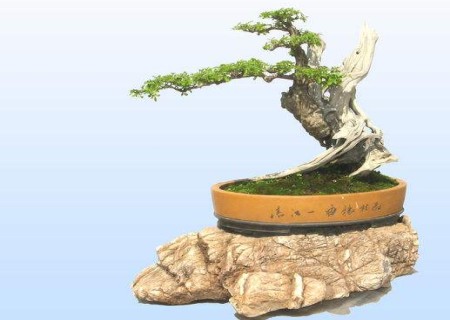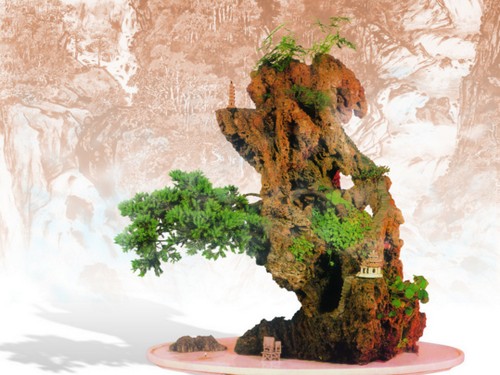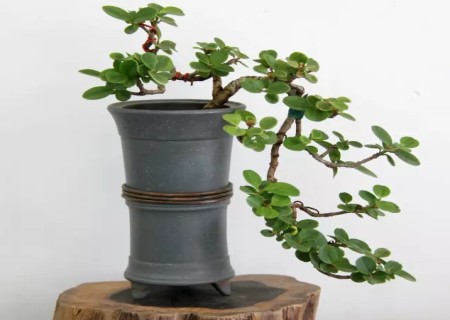Production Technology of Bauhinia Bonsai
Bauhinia is a common plant in the wild mountains and mountains in the north. What we call bauhinia usually refers to bauhinia. Its trunk is often cracked and rough, looking very simple and vigorous. And its regeneration ability is very strong, not only can withstand strong pruning, but also the branches are very soft and easy to shape, which is very suitable for making bonsai. The old pile material excavated from the wild can easily produce a good piece of bonsai after a little processing.

Bauhinia is a good material for cultivating and making bonsai, and can produce bonsai with different shapes. The following editor will introduce the production technology of Jingtiao bonsai to you. I hope it will be helpful to you.
1. Draw materials
Bauhinia can be propagated by sowing and dividing plants, but bonsai is usually made by cultivating seedlings. It can be cultivated by digging bauhinia stumps in the mountains.
The main results are as follows: 1) it is necessary to choose a good time for digging old stakes in the mountains, usually during the period after falling leaves in early winter and before sprouting in early spring. The mining of stumps is also very particular: first of all, the selected stumps of bauhinia should be examined repeatedly, carefully studied, and the best mining plan should be worked out.
2) when digging the stump, we should take some raw soil with us, and we should not scatter the soil and keep it firmly attached to the root of the stump as much as possible. The unearthed stump material still needs to be processed. Before cultivating stumps, we need to clean up the stumps, remove the stout roots, retain the small roots and hairy roots, and cut off the excess branches.
2. Cultivation
First, the finished stump is planted on the ground, and after the root system of the newly planted stump is stretched into clusters, it can be found that the newly planted stump has survived. At this time, we can dig out the stump again and plant it in the basin. We can find that the viewing point of Bauhinia bonsai is concentrated in the root position, so we should choose a relatively shallow pot when transplanting. Of course, we need to trim it again before transplanting it into the pot. Next, you can start the next step of the operation.
3. Production process
The production process of Bauhinia bonsai is mainly pruning and modeling. First of all, the original is to prune the planted stump of bauhinia. The pruning time is usually in early spring, that is, during March.
Pruning method:
1) for the trunk, we can cut off most of the original branches on the stump, but leave a certain length of thick branches in the basic position, that is, the trunk. After some new branches sprout from the stump, a new crown will be formed slowly. At this point, we need to prune the branches, but pay attention to the position and direction of the new buds.
2) for the root system, we also need to prune it. But when we trim the roots during this period, we also need to retain the fibrous and capillary roots. It should be noted that if the current root system is not quite in line with our idea of making bonsai, then we can use rice dumplings to tie the roots into the shape of undulating highlands. Of course, some bark may be hurt in the process of Panza, but please don't be distressed, we can ignore this. Because the injured bark will slowly heal the wound and form scars of various shapes with the passage of time in the future, which can better show the simple posture of the bauhinia stump, isn't it more attractive?
Modeling method:
During the growth of the stump, we need to repeatedly top and pick buds, so that not only the leaves of the trees become smaller and shorter, but also the branches become denser and denser, thus forming a more compact crown, which is more stylish and more ornamental.
In the process of making Jingtiao bonsai, we can make a variety of bonsai shapes according to our own ideas, and each shape can have different forms of expression. However, the branches of bonsai will not grow according to people's wishes, so it is necessary for us to prune and shape the bonsai, so that it can maintain a good shape for a long time. Of course, in order to improve the ornamental value of the bonsai, we can also use brown rope and other related tools to model it more harshly. After the bonsai is redefined, we will remove the brown rope from various parts of the bonsai.
4. Maintenance and management
After making the bauhinia bonsai, we can maintain and manage it normally. According to the growth habits of the bauhinia, we need to place the bonsai in a sunny and well-ventilated environment for maintenance, and it is suggested that the bonsai should be turned around at regular intervals, so that the whole bonsai work can be "taken care of" by lighting, ventilation and other conditions in all locations.
In addition, in the daily management, we need to properly control the water and fertilizer of Jingtiao bonsai, which can not only restrain the excessive growth of bonsai, but also improve the appreciation of bonsai.
Time: 2019-05-26 Click:
- Prev

The method of making rockery bonsai
Bonsai is a kind of three-dimensional painting. After the artistic processing of the author, it carries on the magical treatment of moving the sky and shrinking the earth, and reproduces the natural beauty in the form of mountains, plants and accessories. The rockery is the main body of the rock bonsai, and only the rockery has been made.
- Next

Production Technology of Poplar Bonsai
Boxwood, also known as sparrow tongue boxwood, pearl boxwood, its tree shape is beautiful, and thick and accompanied by luster, the most important thing is that boxwood is evergreen all the year round, it is a precious material for bonsai production, it can be made into bonsai masterpieces for the world to watch. If the old yellow poplar piles are excavated from the mountains to create bonsai.
Related
- Fuxing push coffee new agricultural production and marketing class: lack of small-scale processing plants
- Jujube rice field leisure farm deep ploughing Yilan for five years to create a space for organic food and play
- Nongyu Farm-A trial of organic papaya for brave women with advanced technology
- Four points for attention in the prevention and control of diseases and insect pests of edible fungi
- How to add nutrient solution to Edible Fungi
- Is there any good way to control edible fungus mites?
- Open Inoculation Technology of Edible Fungi
- Is there any clever way to use fertilizer for edible fungus in winter?
- What agents are used to kill the pathogens of edible fungi in the mushroom shed?
- Rapid drying of Edible Fungi

